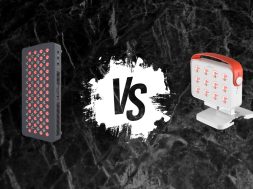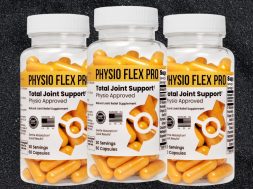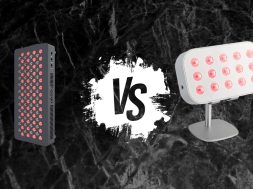
Red light therapy has gone from being a niche recovery trick used by elite athletes to something you can do at home between training sessions or while watching TV. The appeal is simple — faster recovery, less pain, better skin, and improved joint function without medications or downtime. For guys who train hard, work full-time, and balance family life, that kind of efficiency matters.
Two of the most talked-about portable options right now are the Hooga Red Light Therapy Belt and the Joovv Go 2.0. Both promise clinical-grade wavelengths, quick sessions, and genuine recovery benefits packed into travel-friendly designs. But they go about it differently: Hooga focuses on simplicity and targeted muscle recovery, while Joovv leans on sleek design, app integration, and premium feel.
After testing both for several weeks, I’ve seen what each can and can’t do. This review breaks down their real-world performance, design, and value, and finishes with an honest recommendation for which one’s worth your time, and when you might want to skip both for something better.
| Feature | Winner |
|---|---|
| Performance & Effectiveness | Joov |
| Wavelengths | Joov |
| Design & Build Quality | Draw |
| Ease of Use | Hooga |
| Battery | Draw |
| User Reviews | Draw |
| Price | Hooga |
Quick Verdict
Both devices work, but they serve different types of users.
The Hooga Red Light Therapy Belt is the more practical, everyday option. It’s hands-free, easy to use, and great for targeting sore muscles or joints after training. It lacks customization and smart features, but for straightforward recovery, it gets the job done.
The Joovv Go 2.0 feels like the premium, tech-forward version. Its design and build quality are excellent, and the pulsed Recovery+ mode adds some versatility.
But the small coverage area, fixed 10-minute timer, and handheld use make it less convenient for consistent, post-training recovery.
Still, if you want deeper relief and faster results, the Kineon MOVE+ Pro clearly outperforms both. Its laser-assisted modules and hands-free system deliver superior recovery and joint health benefits.
What Is the Hooga Red Light Therapy Belt?
The Hooga Red Light Therapy Belt is a portable, battery-powered recovery tool designed to deliver red (660 nm) and near-infrared (850 nm) light directly into muscles and joints.
It uses the same clinically supported wavelengths found in larger light panels but packs them into a flexible wrap you can strap around sore areas like the lower back, quads, shoulders, or knees.
What separates the Hooga belt from cheaper gadgets is how well it balances simplicity and performance. You strap it on, press one button, and it runs a 20-minute session automatically.
The dual-wavelength output supports both surface-level and deep-tissue recovery, helping reduce inflammation, ease soreness, and even improve skin texture over time.
It’s lightweight (under a pound), built from sturdy materials, and runs several sessions on a single charge. For me, that meant being able to throw it on post-workout while prepping dinner or scripting my next video.
Still, it’s not perfect. The velcro straps start to show wear with daily use, the warmth can feel intense in hot climates (I live in Texas), and without intensity settings or app control, you’re stuck with one fixed power level. But for a straightforward recovery device that simply works, the Hooga delivers solid value.
You can read my Hooga review for my experience.
Pros
- Effective dual-wavelength therapy (660 nm + 850 nm) for muscle and joint recovery
- Portable, lightweight, and battery-powered for hands-free sessions
- Simple, one-button operation with automatic 20-minute shutoff
- Noticeable reduction in soreness and stiffness with consistent use
- Durable build quality for the price
Cons
- No intensity or mode adjustments
- Velcro straps may wear over time
- Limited coverage for larger body areas
- Generates moderate heat during use
- No smart features or app connectivity
What Is the Joovv Go 2.0?
The Joovv Go 2.0 is a premium handheld red light therapy device that packs professional-grade wavelengths (660 nm red and 850 nm near-infrared) into a travel-sized unit.
It’s built for portability and precision, making it ideal for quick, targeted sessions on areas like the shoulder, knee, or neck.
The device feels solid and well-designed, with a comfortable silicone grip and clean finish that speaks to Joovv’s reputation for quality.
Through its companion app, you can choose between red, infrared, or combined light modes, plus a Recovery+ pulsed option designed to boost circulation and reduce inflammation. The app also tracks usage, though Bluetooth can occasionally be glitchy.
Each session runs for 10 minutes with automatic shutoff. That’s great for safety and consistency, but it can be restrictive when you want longer treatments or need to hit multiple areas.
Still, the light output is strong, even, and effective, and I noticed reduced shoulder stiffness and quicker muscle recovery after a week of consistent use.
Where the Go 2.0 falls short is in convenience. You need to hold it in place the whole time, and it requires short cooldowns between sessions.
For quick, focused recovery or skincare use, it’s excellent. But for daily, hands-free therapy, it’s not the most practical option. You can read my Joovv review for my experience.
Pros
- Portable, durable, and premium feel
- Effective dual wavelengths (660 + 850 nm)
- Pulsed Recovery+ mode for enhanced results
- App integration for tracking and settings
Cons
- High price for a small device
- Must be handheld — no hands-free use
- Small coverage area and fixed 10-minute sessions
- Occasional Bluetooth connection issues
Hooga vs Joovv: Main Differences
Performance and Effectiveness
Both devices use clinically validated wavelengths (660 nm and 850 nm), and both produce measurable results when used consistently.
In my testing, the Hooga Belt proved more practical for actual training recovery. Because it’s wearable and hands-free, I could strap it around my lower back or knees and still move relatively freely, or at least work on my computer.
After a few days of consistent use, muscle tightness eased noticeably, and joint stiffness was reduced. It’s not instant, but it’s reliable.
The Joovv Go 2.0 also definitely works. Its power output is strong, and the Recovery+ pulsed mode adds an extra edge for localized pain or inflammation.
But the trade-off is convenience. Holding it in place for 10 minutes per session becomes tedious fast, especially if you’re trying to treat more than one area.
For quick spot work (like a cranky shoulder or elbow), it’s excellent. For full recovery routines, it slows you down.
Wavelengths
Both devices emit 660 nm red light for surface-level healing and 850 nm near-infrared for deeper tissue work. That combination is the industry standard because it hits both layers — improving circulation, reducing inflammation, and boosting mitochondrial function.
Where Joovv gets a small edge is in control. Through its app, you can switch between red, infrared, or combined modes, and activate the pulsed Recovery+ setting for extra cellular stimulation. It’s a subtle but useful feature for targeted relief.
Hooga, meanwhile, keeps things simple with no modes or customization, offering steady dual-wavelength output every time. The power density is strong enough for recovery, though slightly less concentrated than Joovv’s focused LEDs.
Design and Build Quality
Design philosophy is where these two products completely diverge.
The Joovv Go 2.0 feels like a piece of premium tech. It’s compact, weighty, and built with high-grade materials. The silicone grip fits naturally in the hand, the LED layout is perfectly even, and even the optional charging dock feels refined. It’s the kind of device you wouldn’t mind leaving on your nightstand.
The Hooga Belt, in contrast, feels more like a piece of gym gear. It’s built for function, not style, sporting a soft, flexible fabric, a slightly stiff LED panel, and adjustable velcro straps that secure it tightly to the body.
After several weeks of use, the only minor issue was the velcro starting to show wear, which isn’t surprising given daily use. Still, the build holds up, and the materials feel sturdy enough for athletes who’ll actually put it through work.
Ease of Use
This is where Hooga really shines. It’s built for simplicity, featuring one button, automatic 20-minute sessions, and no app or learning curve.
You put it on, press start, and forget about it until it shuts off. That’s a huge advantage if you’re juggling training, work, and family. I often wore it while working at my desk or doing light mobility, and it never interrupted the flow of my day.
The Joovv Go 2.0, on the other hand, demands your full attention. You have to hold it 6–12 inches away for 10 minutes, then let it cool down before starting again.
The app offers more control, but it also adds friction through occasional pairing issues and updates that can break the rhythm of what should be a simple recovery routine.
For the average lifter or grappler who just wants to recover fast and move on, Hooga’s ease of use is hard to beat.
Battery Life and Hardware
Both devices hold up well in day-to-day use.
The Hooga Belt runs about 4–6 sessions on a full charge, enough for a few days of consistent use. It charges via USB-C in about 2–3 hours, and because it’s fully wireless, you can use it anywhere.
The Joovv Go 2.0 lasts slightly longer at roughly 6–8 sessions, and its magnetic charging dock adds convenience, though it also makes the setup bulkier and less portable.
Hardware-wise, Joovv’s design feels more refined, while Hooga’s focus on flexibility makes it more functional for different muscle groups. Both have solid durability, but Hooga’s wearable format gives it a small edge for real-world recovery.
Price
| Device | Type | Wavelengths | Price |
| Hooga Red Light Therapy Belt | Wearable belt | 660 nm + 850 nm | $299 |
| Joovv Go 2.0 | Handheld | 660 nm + 850 nm | $499 (without dock) / $599 (with dock) |
| Kineon MOVE+ Pro | Modular wearable | 660 nm + 808 nm (laser + LED) | $499 |
My Experience With Hooga Red Light Therapy Belt and Joovv Go 2.0
Using the Hooga Belt
I started with the Hooga Red Light Therapy Belt during one of my heavier training blocks, which included lots of squats, snatches, and long grappling sessions that usually leave my lower back and knees tight for days.
The first thing that clicked with me was its simplicity. No setup, no pairing, no fuss — just strap it on, press one button, and it runs for 20 minutes before shutting off automatically.
I used it mostly on my lower back after lifting and on my knees post-grappling. Because it’s hands-free, I could move around, stretch, or even cook while it worked, which made consistency effortless.
After about a week of daily use, I noticed less lingering tightness in my back and knees, especially on the mornings after intense sessions.
By week three, that improvement became part of my baseline as recovery felt smoother, and soreness rarely carried over between training days. The gentle warmth was actually relaxing, though in the Texas heat it could get a bit much during longer sessions.
One small downside was the velcro straps showing wear after a month of near-daily use. They still held fine but looked a little frayed. And while the belt’s coverage is solid for localized treatment, it takes extra time if you want to hit multiple muscle groups.
Still, the Hooga Belt became a go-to recovery tool in my rotation. It’s reliable, simple, and effective, something I actually used consistently because it fit my life.
My Experience With the Joovv Go 2.0
A few months later, I tested the Joovv Go 2.0 during a different training phase with a similar load, just with more overhead pressing.
My left shoulder has been a chronic weak point for years, so this seemed like the perfect time to see how Joovv’s handheld system performed.
The first impression was excellent. The device feels premium and is well-balanced, sturdy, and comfortable to hold. Setup took a few minutes, pairing with the app was straightforward, and I liked having the ability to switch between red, infrared, and pulsed Recovery+ modes.
I used it almost daily for about a month, focusing mostly on my shoulder, neck, and sometimes my lower back. The 10-minute sessions fit neatly into my post-training routine.
The warmth was noticeable but never harsh, and after a week, I began feeling less morning stiffness in my shoulder and improved range of motion.
The biggest challenge was the manual use. Holding it in place for the full 10 minutes became repetitive, especially when treating more than one area.
The app connection also dropped a few times, forcing manual restarts. Still, when it worked, it worked well. The localized relief was undeniable, especially after hard upper-body days.
Where the Joovv really impressed me was consistency of effect. The shoulder pain that usually lingers after pressing volume was noticeably less intrusive, and my neck tension from grappling eased quicker than usual. It’s not a miracle tool, but the improvements were steady and predictable.
Over time, I found myself using it more as a focused recovery or maintenance device. Something I’d grab for targeted relief rather than broad sessions.
For that role, it’s excellent. But compared to the hands-free practicality of the Hooga or the deeper penetration of the Kineon MOVE+ Pro, it requires more patience and time commitment.
Should You Get Hooga or Joovv?
Choosing between the Hooga Red Light Therapy Belt and the Joovv Go 2.0 really comes down to how you plan to use red light therapy and how much time you’re willing to dedicate to it. Both are legitimate recovery tools backed by real science, but they cater to very different types of users.
If your goal is practical, everyday recovery, the Hooga Belt is the smarter buy. It’s hands-free, simple, and consistent, and the kind of tool you’ll actually use day after day.
For athletes, lifters, and anyone managing sore muscles or stiff joints, it fits perfectly into a routine without demanding extra time or focus.
You can wear it while doing chores, watching your kids, or even working at your desk. That convenience turns occasional therapy into a daily habit, which is where real results come from.
On the other hand, the Joovv Go 2.0 is more of a precision instrument. It’s ideal if you’re after targeted, high-quality therapy in a compact format.
Its app integration, pulsed Recovery+ mode, and sleek design make it feel premium, and it shines for small, specific problem areas like shoulders, elbows, or neck stiffness. It’s also great for skin health or cosmetic use — areas where the Hooga feels a little overbuilt.
That said, Joovv demands more effort. You have to hold it in place, time your sessions, and occasionally fight with the Bluetooth connection. For someone with a tight schedule or multiple sore spots, that becomes a bottleneck fast.
For value and practicality, Hooga wins. For polish and focused, short treatments, Joovv has the edge.
But if your real goal is deep recovery and long-term joint health, neither quite reaches the level of the Kineon MOVE+ Pro. Its hybrid laser-LED setup, adjustable straps, and customizable sessions deliver stronger penetration and faster results than either device. For athletes, grapplers, or lifters dealing with chronic inflammation or overuse pain, it’s simply in another class.
Kineon MOVE+ Pro
Kineon MOVE+ Pro
Powerful red light therapy device designed be applied without having to sit in front of a large light panel.
CHECK CURRENT DEALS











